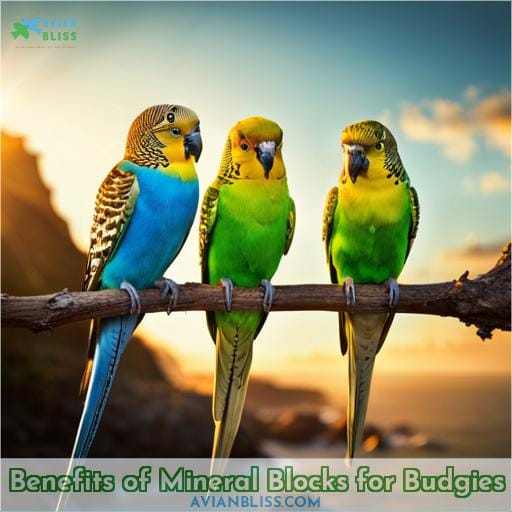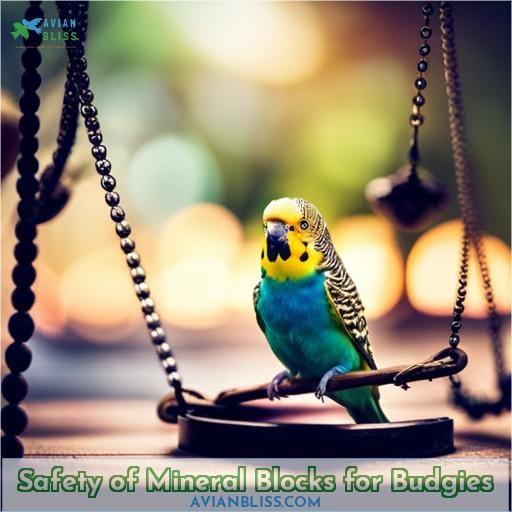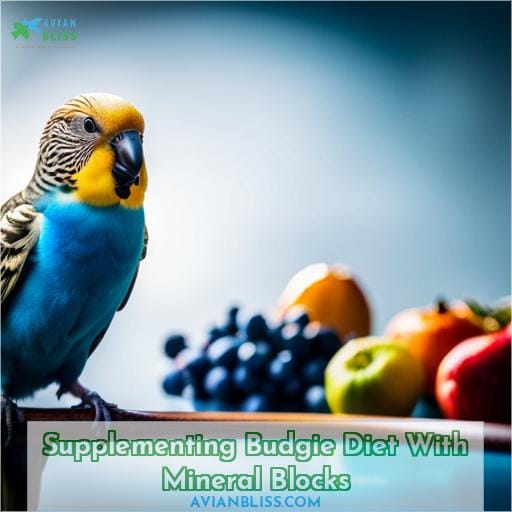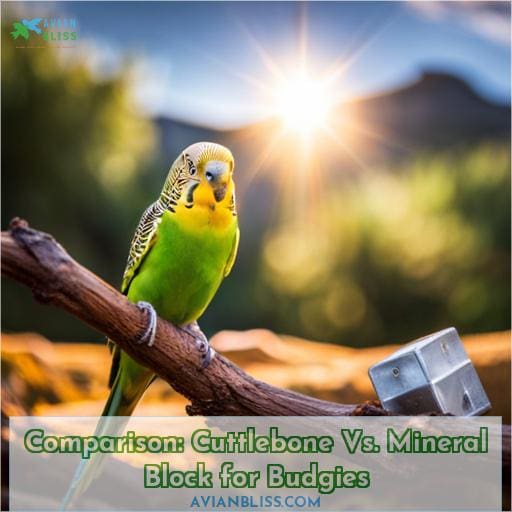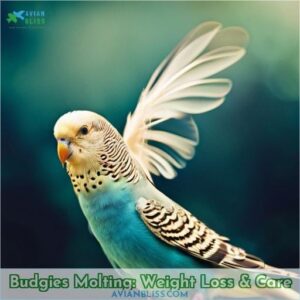This site is supported by our readers. We may earn a commission, at no cost to you, if you purchase through links.
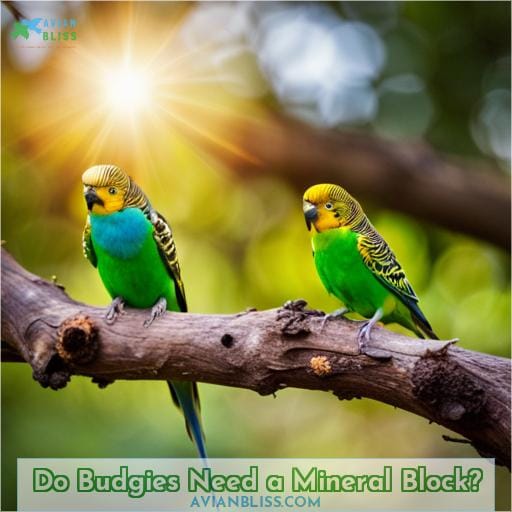 Step into the world of budgie care and discover if these charming birds need a mineral block for optimal health. Your feathered friend’s beak maintenance and overall well-being may benefit from this small addition to their cage.
Step into the world of budgie care and discover if these charming birds need a mineral block for optimal health. Your feathered friend’s beak maintenance and overall well-being may benefit from this small addition to their cage.
But how do you choose the right one? And are there any safety considerations to keep in mind? Join us as we explore the importance of mineral blocks for budgies, helping you make informed decisions about your pet’s diet and enrichment needs.
Table Of Contents
- Key Takeaways
- Benefits of Mineral Blocks for Budgies
- Choosing the Right Mineral Block for Budgies
- Safety of Mineral Blocks for Budgies
- Supplementing Budgie Diet With Mineral Blocks
- Comparison: Cuttlebone Vs. Mineral Block for Budgies
- Homemade Mineral Blocks for Budgies
- Frequently Asked Questions (FAQs)
- Can budgies become dependent on mineral blocks for their nutritional needs?
- Are mineral blocks suitable for all ages of budgies?
- How often should mineral blocks be replaced in a budgie’s cage?
- Can budgies overconsume mineral blocks?
- Are there any potential side effects or risks associated with using mineral blocks for budgies?
- Conclusion
Key Takeaways
- Help keep beaks free of messes
- Aid in preventing overgrown beaks
- Provide essential nutrients
- Reduce the risk of common beak diseases
Benefits of Mineral Blocks for Budgies
Mineral blocks offer several benefits for budgies, particularly in terms of beak maintenance and health.
These blocks help to keep the beak free of messes after eating and remove food debris that may get stuck.
Additionally, mineral blocks aid in preventing overgrown beaks by providing a natural way for budgies to wear down their beaks.
Beak Maintenance
Using a mineral block can help your budgie keep its beak clean and free of messes.
It provides essential nutrients that help remove food debris, keeping the beak healthy and preventing overgrowth.
Regular use of a mineral block also helps the beak stay strong, ensuring proper grooming and functionality.
By incorporating a mineral block into your budgie’s care routine, you’re empowering them with the tools they need for optimal beak maintenance and overall well-being.
Beak Health
Mineral blocks are essential for maintaining the beak health of your budgies.
These blocks play a crucial role in promoting proper beak growth, shape, and color.
They also aid in beak grooming by helping to remove food debris and prevent overgrowth.
By providing necessary minerals, mineral blocks contribute to overall beak health and reduce the risk of common beak diseases.
Including mineral blocks as part of your budgie’s care routine ensures their well-being and supports their natural instincts for liberation and power within their environment.
Choosing the Right Mineral Block for Budgies
When choosing a mineral block for your budgie, it’s important to carefully check the ingredients before making a purchase.
Avoid products that contain manmade substances or artificial coloring and flavorings.
Additionally, pay attention to the safety of the clip that attaches the block to the cage, ensuring it isn’t made of metal and finding an alternative attachment method if necessary.
Checking Ingredients
To choose the right mineral block for your budgie, carefully check the ingredients before making a purchase.
- Look for natural, no-frills options that are safe and beneficial for your bird.
- Avoid products with artificial coloring or flavorings, as well as those containing manmade substances (charcoal is an exception).
- Homemade mineral blocks can also be considered using a mixture of ground-up shell, fine mineral grit, crushed eggshell from chickens, charcoal,cuttlefish bone,and calcium powder.
Avoiding Harmful Substances
When selecting a mineral block for your budgie, make sure to steer clear of products that contain:
- Manmade substances
- Artificial coloring or flavorings
These can be harmful to your bird’s health and may cause adverse reactions.
To ensure the safety of your budgie, avoid metal clips as they can pose a risk of injury.
Instead, opt for natural options like cuttlebone or homemade mineral blocks made with safe ingredients such as basil and fruit.
Clip Safety
To ensure the safety of your budgie, it’s important to pay attention to the clip that attaches the mineral block to their cage.
Metal clips can be dangerous if they’ve sharp edges or are prone to breaking off.
Additionally, make sure that the clip doesn’t contain any toxic paint or substances that could harm your bird.
Choosing a safe and secure attachment for the mineral block will help prevent any accidents and keep your budgie healthy while enjoying its essential minerals.
Safety of Mineral Blocks for Budgies
As an avian veterinarian, it’s important to consider the safety of mineral blocks for budgies.
One key aspect of their safety is that they’re zinc-free, as zinc can be toxic to birds. This ensures that budgies can safely nibble on the block without any risk of poisoning.
Additionally, it’s safe to leave the mineral block in the cage at all times, even if your budgie isn’t showing much interest in it initially.
Zinc-Free Composition
For the safety of your budgie, it’s important to ensure that mineral blocks are zinc-free.
Zinc can be toxic to birds and pose a threat to their health.
When choosing a mineral block for your budgie, make sure it contains no traces of zinc.
Opt for natural and safe compositions that provide essential minerals without any harmful substances.
Prioritize the well-being of your budgie by selecting a healthy and risk-free option for their diet needs.
Leaving the Block in the Cage
Now let’s explore the safety aspect of leaving the mineral block in your budgie’s cage.
It’s important to consider factors such as:
- Block size
- Shape
- Placement
- Cage location
to ensure the well-being of your feathered friend.
The mineral block should be securely attached and easily accessible for your budgie to nibble on when needed.
Ensuring proper safety measures will contribute to your budgie’s overall health and happiness.
Supplementing Budgie Diet With Mineral Blocks
Supplementing your budgie’s diet with mineral blocks can be beneficial, but it’s important to remember that they aren’t a substitute for a good diet.
While mineral blocks provide essential calcium and minerals, it’s crucial to also offer your budgie a variety of fresh fruits and vegetables rich in these nutrients.
By incorporating both mineral blocks and a balanced diet, you can ensure that your budgie receives the necessary supplements for optimal health.
Not a Substitute for a Good Diet
You shouldn’t rely on mineral blocks as a substitute for a good diet when it comes to supplementing your budgie’s nutritional needs.
While mineral blocks can provide extra calcium and prevent deficiencies, they can’t replace the overall nutrition that a well-balanced diet provides.
It’s important to avoid overeating minerals from these blocks, as excessive intake of certain minerals like zinc can be toxic to budgies.
A balanced diet with fresh fruits and vegetables promotes good health in budgies.
Supplementing Calcium and Minerals
To ensure your budgie’s diet includes essential calcium and minerals, supplementing with mineral blocks is recommended.
Budgies require a balanced intake of calcium, phosphorus, iron, magnesium, and manganese for optimal health.
Mineral blocks are a convenient way to provide these necessary nutrients to your bird. They contain the essential minerals in an easily accessible form that budgies can nibble on as needed.
By incorporating mineral blocks into their diet along with fresh fruits and vegetables, you can help support your budgie’s overall well-being.
Fresh Fruits and Vegetables
Incorporating fresh fruits and vegetables into your budgie’s diet is essential for supplementing their nutrition with vital vitamins and minerals.
- Fresh fruits and vegetables provide a high nutritional value that supports overall health.
- Offering a variety of colorful options ensures they receive a range of nutrients.
- Vary the shape, size, and texture to encourage foraging behavior and mental stimulation.
Comparison: Cuttlebone Vs. Mineral Block for Budgies
When considering the comparison between cuttlebone and mineral blocks for budgies, it’s important to understand their respective functions and benefits.
Cuttlebone provides a source of calcium and offers pleasure for budgies, while mineral blocks fulfill a similar function by supplying essential minerals.
Placement-wise, cuttlebones should be accessible to budgies with access to the soft side, while mineral blocks can be left clipped to the cage at all times.
Regular maintenance involves simply giving soiled cuttlebones a dry scrub with a wire brush, whereas caution should be exercised when selecting mineral blocks that don’t contain artificial substances or coloring.
Function and Benefits
When comparing the function and benefits of cuttlebone to mineral blocks for budgies, it’s important to understand their differences in providing essential minerals.
While both options provide necessary nutrients, mineral blocks offer additional advantages such as helping with digestion, promoting healthy growth, and boosting the immune system.
To highlight these distinctions further, refer to the table below:
| Function | Cuttlebone | Mineral Block |
|---|---|---|
| Provide Nutrients | ||
| Prevent Deficiency |
Help with Digestion
Promote Healthy Growth
Boost Immune System
By examining these functions and benefits side by side, you can make an informed decision about which option best suits your budgie’s needs.
Placement and Maintenance
Place the cuttlebone or mineral block in a location accessible to your budgie for optimal maintenance and health benefits.
Ensure that it’s at an appropriate height so that your budgie can easily reach it without straining.
Consider the size and shape of the block, making sure it fits comfortably within their cage without obstructing movement.
Regularly clean and maintain the block to prevent bacterial growth or accumulation of debris.
Replace as needed based on frequency of use and wear.
Homemade Mineral Blocks for Budgies
Now let’s discuss the option of creating homemade mineral blocks for your budgies. DIY recipes can ensure that you have control over the ingredients and quality of the block.
By using a mixture of ground-up shell, fine mineral grit, crushed eggshell, charcoal, cuttlefish bone, and a calcium powder binder like Plaster of Paris, you can provide your budgies with a customized mineral block that meets their specific needs while ensuring safety and quality.
DIY Recipe
To make homemade mineral blocks for your budgies, you can easily create a mixture using:
- Ground-up shell
- Fine mineral grit
- Crushed eggshell
- Charcoal
- Cuttlefish bone
- A calcium powder like Plaster of Paris
Combine these DIY ingredients thoroughly and shape the mixture into blocks. Allow them to dry completely before offering them to your budgies. Store the homemade mineral blocks in an airtight container to maintain their freshness and effectiveness.
These DIY mineral blocks provide essential minerals for your budgie’s health benefits.
Ensuring Safety and Quality
To ensure the safety and quality of homemade mineral blocks for your budgies, follow a trusted recipe and carefully select high-quality ingredients.
Use non-toxic ingredients to avoid any harm to your birds.
When attaching the mineral block to their cage, avoid metal clips that may pose a risk of injury.
Additionally, be cautious about excess salt in the homemade recipes as too much can be harmful to budgies.
By taking these precautions, you can provide safe and beneficial mineral blocks for your feathered friends.
Frequently Asked Questions (FAQs)
Can budgies become dependent on mineral blocks for their nutritional needs?
Budgies can’t become dependent on mineral blocks for their nutritional needs. While the blocks can supplement their diet, a balanced and varied diet is essential to provide all necessary nutrients.
Are mineral blocks suitable for all ages of budgies?
Mineral blocks are suitable for all ages of budgies. Like a key to unlock their potential, these blocks provide essential nutrients and contribute to their overall well-being. Ensure your feathered friend has access to this valuable resource throughout their life.
How often should mineral blocks be replaced in a budgie’s cage?
To ensure your budgie receives optimal mineral supplementation, replace the mineral block in their cage every 2-3 months. This will guarantee that they’ve access to essential nutrients and maintain a healthy beak.
Can budgies overconsume mineral blocks?
Budgies can overconsume mineral blocks if given unrestricted access. While they provide essential nutrients, excessive intake may lead to imbalances. Monitor their consumption and consult a veterinarian for guidance on the appropriate amount for optimal health.
Are there any potential side effects or risks associated with using mineral blocks for budgies?
Using mineral blocks for budgies doesn’t pose any significant risks or side effects.
They’re safe and can be left in the cage at all times, providing essential minerals as needed.
Conclusion
To ensure optimal health and well-being for your budgie, providing a mineral block is highly beneficial. This small addition to their cage aids in beak maintenance and promotes beak health.
When choosing a mineral block, carefully check the ingredients and avoid harmful substances. Safety considerations include opting for a zinc-free composition and securely clipping the block in the cage.
Remember that mineral blocks should supplement, not substitute, a good diet. Supplementing with calcium and minerals, along with fresh fruits and vegetables, will contribute to your budgie’s overall health.

